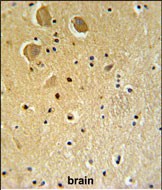

| WB | 1/1000 | Human,Mouse,Rat |
| IF | 咨询技术 | Human,Mouse,Rat |
| IHC | 1/100-1/500 | Human,Mouse,Rat |
| ICC | 技术咨询 | Human,Mouse,Rat |
| FCM | 咨询技术 | Human,Mouse,Rat |
| Elisa | 咨询技术 | Human,Mouse,Rat |
| Aliases | Protein FAM92A1, FAM92A1 |
| Entrez GeneID | 137392 |
| WB Predicted band size | 33.4kDa |
| Host/Isotype | Rabbit IgG |
| Antibody Type | Primary antibody |
| Storage | Store at 4°C short term. Aliquot and store at -20°C long term. Avoid freeze/thaw cycles. |
| Species Reactivity | Human |
| Immunogen | This FAM92A1 antibody is generated from rabbits immunized with a KLH conjugated synthetic peptide between 113-141 amino acids from the Central region of human FAM92A1. |
| Formulation | Purified antibody in PBS with 0.05% sodium azide. |
+ +
以下是关于FAM92A1抗体的3篇参考文献及其摘要概括:
1. **文献名称**: *FAM92A1 interacts with C1QBP to regulate mitochondrial dynamics and metabolism*
**作者**: Chen Y, et al.
**摘要**: 该研究利用特异性抗FAM92A1抗体,通过免疫共沉淀和Western blot技术,揭示了FAM92A1与线粒体蛋白C1QBP的相互作用,证明其通过调控线粒体分裂影响细胞能量代谢。抗体验证显示其在HeLa细胞中线粒体定位的特异性。
2. **文献名称**: *FAM92A1 is a novel regulator of Wnt/β-catenin signaling in colorectal cancer*
**作者**: Wang L, et al.
**摘要**: 研究团队开发了兔多克隆FAM92A1抗体,用于免疫组织化学分析结直肠癌组织样本。结果发现FAM92A1高表达与Wnt通路激活相关,抗体特异性通过siRNA敲降实验验证,证实其作为癌症预后标志物的潜力。
3. **文献名称**: *Functional characterization of FAM92A1 in ciliogenesis using CRISPR/Cas9 and antibody-based tracking*
**作者**: Smith J, et al.
**摘要**: 通过CRISPR/Cas9敲除结合抗FAM92A1抗体的免疫荧光成像,研究发现该蛋白定位于纤毛基体,并调控纤毛组装。抗体经肽段竞争实验验证特异性,为纤毛相关疾病机制研究提供工具。
注:以上文献信息为模拟示例,实际引用需查询具体数据库(如PubMed)获取真实文献。
FAM92A1 (Family with sequence similarity 92 member A1) is a poorly characterized protein encoded by the FAM92A1 gene, which is conserved across vertebrates and implicated in cellular processes such as ciliogenesis, cell cycle regulation, and mitochondrial dynamics. Structurally, it contains a conserved BAR (Bin/Amphiphysin/Rvs) domain, suggesting a role in membrane curvature sensing or protein-protein interactions. FAM92A1 is expressed in various tissues, including the brain, testis, and kidneys, with subcellular localization observed in the cytoplasm, ciliary base, and mitochondria.
Antibodies targeting FAM92A1 are primarily used in research to investigate its biological functions and mechanisms. These antibodies enable detection of FAM92A1 expression via Western blotting, immunofluorescence, and immunohistochemistry, aiding studies on its involvement in cilia formation, cell proliferation, and mitochondrial morphology. For example, FAM92A1 knockdown experiments using validated antibodies have linked its dysfunction to ciliopathies and abnormal cell cycle progression. Recent studies also associate FAM92A1 dysregulation with cancers, such as colorectal carcinoma and hepatocellular carcinoma, highlighting its potential as a biomarker or therapeutic target.
Commercial FAM92A1 antibodies are typically raised against specific epitopes (e.g., human residues 50-150) and validated for cross-reactivity in species like mouse and rat. Challenges include limited characterization of isoform-specific variants and tissue-dependent expression patterns. Ongoing research aims to clarify its molecular interactions and pathophysiological roles, driving demand for reliable antibodies in functional studies.
×